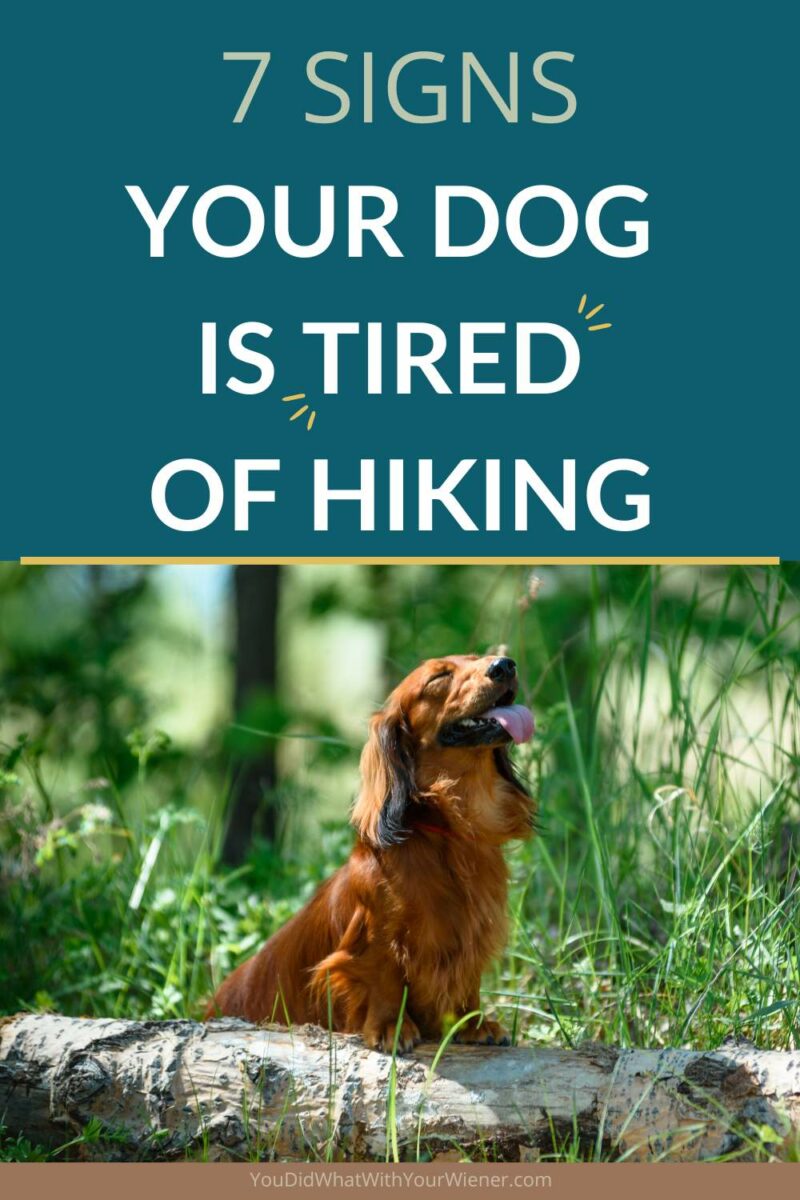How to Tell if Your Dog is Tired of Hiking
As you know, I’m all about hiking with dogs. I believe that almost any dog in good health can do it.
However, it IS true that not all dogs can go the same distance or over the same terrain.
If your dog has never been hiking before, you should start them slow on easier trails and work your way up to more difficult hikes.

Even dogs that love hiking and have been hiking for years have their limits though.
It’s important to know when your dog has had enough hiking for the day.
LAST UPDATED: January 21, 2023
Don’t Make My Mistake
Many years ago I made the mistake of pushing my Dachshund Chester too far on the trail.
I didn’t notice that he was getting tired and overheating.
I’ll admit that I knew way less about hiking with dogs back then.
It turns out that this is one of the most common newbie hiking mistakes.
I was too busy being proud that my 12 lb dog hiked almost 15 miles that day to notice that he was becoming exhausted.
I would like to say that was the last time that I accidentally let my dog’s push themselves too far. Unfortunately, it wasn’t.
While the later incidents were never as bad as that first one, there were a few situations where I could have been a better hiking partner and pet parent.
Over the years, I’ve learned my lesson.
Now I am hyper-vigilant about making sure I’m meeting their needs.
Does that mean that I never make mistakes when hiking long distances with my dogs? No.
The point though is that I learn from them and do better next time.
Sometimes it takes making mistakes to learn where your dog’s limits are.
For example, they may seem totally fine on the trail but you notice they are sore and walk really stiff the next morning.
Or maybe, like happened with Gretel once, she was very enthusiastic on the trail but then started walking stiff and passed out from exhaustion when we got back to the car.
It’s through reading as much as I can about trail illnesses and injuries in dogs, and hiking with my dogs for 15 years, that I’ve learned to how much hiking is too much for my dogs.
Do Dogs Get Sore From Hiking?
Dogs can definitely get sore from hiking. The problem is that you might not know it.
Dogs are great at hiding pain. They may be sore, stiff, or uncomfortable and never show signs.
Your dog could push themselves so hard to keep up with you on the trail that they get sore or injure themselves.
When this gets extreme, you may see signs during your hike.
But your dog could also have sore muscles and joints after the hike.
It’s often more difficult to detect because one sign your dog is sore is that they sleep a lot, which most dogs do a lot of at home anyway.
You are also likely distracted with tasks at home and may be too focused on other things to notice your dog is acting sluggish, sighing more than usual, or quietly whining.
Signs Your Dog is Approaching Exhaustion:
The most important step in preventing an injury or illness when your dog is hiking is knowing their individual warning signs.
Every dog is different so it’s important to know your own dog.
However, there are some common signs your dog might be tired of hiking:
- Lagging behind – A dog may start out strong and fast on a hike and then naturally slow down when the pent-up energy has dissipated. But if your dog starts significantly lagging behind, or stopping to sniff everything, they may be trying to tell you they’re tired of hiking.
- Labored breathing – If your dog is “heaving” when it breathes, or if its breath doesn’t start to go back to normal after a 15 minute break, it’s probably had enough for the day.
- Your dog flops down on the trail – if your dog immediately lies down, and looks a little lethargic, as soon as you stop to take a break, it could be a sign of exhaustion
- Your dog licks a specific spot excessively – If your dog repeatedly a specific area during breaks, they may have an abrasion there. This could be caused by chafing from their collar, harness, jacket or they may have scraped the area on a rock or tree. It can also be a sign of muscle pain.
- Limping – your dog could be limping due to a crack or tear in their paw pad or but limping could also be a sign of a more serious injury like a pulled a muscle or tendon.
- A rapid heart rate (if it stays high after resting) and reddened gums can be an indicator of heat stroke.
- Shivering and breathing slow – A cold dog who is breathing slow and shallow, and seems to be in a stupor-like state, may have hypothermia. This is a common risk during winter but can also happen other times of the year.
If your dog shows more than one of these signs of exhaustion, it’s probably time to call it quits for the day (it definitely is if there are signs of heat stroke or hypothermia).
If my dog’s show even one of the more mild symptoms on this list, although I don’t take it as a sign we need to stop immediately, I start monitoring her very closely for additional signs.
It’s important to have a strategy, or carry an emergency dog sling or a small dog backpack carrier with you, so that you can evacuate your dog if they get to the point they can’t walk out on their own.
Final Thoughts
Dogs make great trail companions.
Unfortunately, I’ve seen many situations where the dog was being pushed to the point that it could cause them harm.
I often hear people say, “My dog will let me know when they’re tired.”
What they don’t understand is dogs will follow their people to the ends of the earth even if it kills them.
I’ve literally seen cases where dogs collapse because they’ve pushed themselves as far as they could possibly go and, sadly, a couple of those dogs died.
People stretch their physical abilities all of the time. That’s how you improve your fitness — through increasingly difficult challenges. The same is true for dogs.
But you want to start with easier hikes and and work your way up to bigger and bigger challenges to get them in shape.
The signs that a dog is being pushed too far are sometimes subtle. Almost never will a dog act like they’ve had enough.
Dogs have the tendency to go-go-go until they physically can’t anymore. It’s up to us, their people, to make sure they don’t overdo it.
Knowing how to identify your dog’s warning signs will help keep them safe and happy on the trails for years to come.


About the Author
Hi, I’m Jessica. I’ve been studying the Dachshund breed since 2007, owned 3 of my own, and shared in the lives of thousands of others through their owner’s stories. When I’m not sharing what I know on this blog, you can find me hiking, camping, and traveling with my adventurous wiener dogs.

Montecristo at 3.5 pounds always stuns me. We recently did 36km in 3 days in the deep woods. We walk in a row with Stefan in the lead, Monte man in the middle and me bringing up the rear. So I watch him… See him. If he slows down I monitor to make sure it’s not fatigue or an injury. Most times he’s just thirsty! Only 2-3 times have we picked him up and put him in a sling bag. These little ones can go!!
That’s great. I actually think being smaller is an advantage because there is less weight to drag up a hill. Having a lower center of gravity helps for sure anyway.
I think Monte would even beat Gretel right now at distance 🙂 We’re doing almost that distance in a couple of weeks. I’m going backpacking with my brother and we’re bringing Gretel. It will be 3 – 5 mile hikes in a row. I am pretty sure she can do it but am still pretty nervous because of her back.
Great information Jessica.
QUESTION:
Do you have any suggested guidelines to follow for my 13 Week old boy William.
I want him to eventually be a hiker but want to work him up slowly. Right now at night we do 3 x 600 yard intervals on the grass apron around a 400 meter track with rest + water in between. It takes us about 7 minutes per lap and we rest for maybe 5 minutes in between. We then may go on a tame walk for another 400 meters so I guess that means the total is about 1 1/3 miles
He runs most of the way. He seems to love it and it is exerting for him. Just wondering if this is too much or I can even take him out for longer distances at this point?
Hi Jerry. Although I commend you for being so careful and responsible, it’s my understanding that much exercise for a pup that young is still a little too much. If I were in your shoes, I might be going with 2-3 of the 600 yard intervals only and skipping the extra walk after. At least for another months or two. Each dog is different though and I trust you would scale back if needed. The problem is that a dog will keep going even though they shouldn’t and could do lasting damage to their joints. This article I wrote might help: https://youdidwhatwithyourweiner.com/how-old-should-my-puppy-be-before-they-hike/
Hi Montecristo Travels,
I was wondering what sling bag you use? We recently just adopted a little 12 pound maltypoo plus a mix of something else and want to get her slowly adjusted to hiking and figured we can combo with a sling bag.
Thanks in advance!
Ashley
My Bailey has that exact problem – she would run insanely until she really couldn’t do anything anymore. It took me a while to really start noticing the first signs of her tiredness, so that now when I notice them, I can stop her and make her drink + rest. If she had it her way, she wouldn’t stop at all! It’s funny that we think dogs aren’t going to overdo themselves, but that’s exactly what happens! Great post! 🙂
Some dogs can self limit correctly but, in my experience, they always push past the point they should have been stopped at. I am super glad to hear you learned to recognize the signs in Bailey.
Faolan will go and go, and go and go. I have to drag him inside at times. My girl sets her own pace, enjoys taking breaks, and lets me know when she is done. I suffered through a heat stroke with an ex boyfriend’s dog, many years ago. Lasix, decadron, mannitol, IV fluids, and a $900 vet bill later, I vowed I would never allow it to happen to another dog in my care later.
Yikes! I bet that was scary. Luckily, my one incident with Gretel was minor. It could have been much worse though 🙁
My dog, Oscar, who is now 15 is smart enough to just sit down when he is tired to let me know he has had enough! We live in extreme heat (New Orleans) so I am walking him at 6 a.m. or earlier to escape the heat. He has lost 8 pounds over the last year and is doing SO SO much better. It is definitely worth it to get out of denial about your dog’s weight if it is excessive. He eats his regular dog food and if he wants snacks he gets carrots, cabbage, pumpkin or other vegetables. Before he lost weight he was paralyzed for 2 weeks and could not go to the bathroom – #1 or #2. Luckily I got the BEST advice ever which was to get the weight off of him. I am grateful to the wise person who woke me up as I was in denial–they are awfully cute when they beg–especially if they go into “tripod” position!
That’s great that Oscar has lost so much weight! We were “lucky” with Gretel’s IVDD back injury because she was already at a healthy weight. The vets told me that it’s the biggest challenge with Dachshunds and IVDD – they are often overweight, which puts strain on their back, but how do you get a dog restricted to 6 weeks crate rest to slim down? Keeping a dog at a healthy weight is one of the most important things owners can do for their dog’s health. On how I know the commitment it takes to ignore those pleading eyes though!
My cat won’t hesitate to just walk away when he’s had enough play, but my dog would go on and on with our walks if I let him! Great post- it’ll definitely help me look for those warning signs, especially in the heat.
What do you do when your pup has had enough before the hike is over? Do you carry them in your arms or do you have something they can ride in?
Ive very rarely had to carry Chester or Gretel. They never seem to tire out before I do. However, I did need to carry Chester out in an emergency once. This was the pack I used (and still cary on every trip as a way to emergency evacuate) http://youdidwhatwithyourweiner.com/rei-flash-18-pack-review-you-put-your-weiner-in-there/. As for carrying a dog regularly, I’ve tried a lot of packs. I have Dachshunds and havn’t found a great solution that is safe for their backs. This is what we’ve used a few times though: http://youdidwhatwithyourweiner.com/backpacks-carrying-dachshund-dog/. My friend uses the Outward Hound front pack for her Chihuahua. I hope that helps.
I just took my rottie, Zoe in a 7 mile hike… the next day she was walking very stiff and today (2nd day) she just stands up to eat and then she goes back to laying down. I think I’m gonna take her to the vet tomorrow…. all I see is that in one of her paws she has a tear but overall I think I exhausted her. ? Thank you for this article!
Hi Luisa. Yes, it does sound like that was too much for her. The first couple times I accidentally pushed Chester too far, I felt like I “broke him”. He barely moved for two days. All he id was sleep and eat. He was totally fine after a big rest but it helped me to learn his limits so I didn’t push him as hard next time. It never hurts to get a vets opinion though if you are not sure that’s the only reason Zoe is acting lethargic.
I also have two Dachshunds like you! They loves run and catch reptiles. I have a plan to hiking with them next year 🙂 Thank for sharing your experiences. I tweeted on my Twitter for my friends 🙂
Thanks for sharing. Hope they love hiking 🙂
Is it normal for a dog to take 2 weeks after a hike and still not be able to get up
Hi Anna. In my experience, no that is not normal. It can indicate an injury like an ACL tear or something. I would definitely take my dog to the vet if they were still “recovering” two weeks later. Gretel has been on a 15-mile hike before, and my previous Dachshund used to run 5 miles with me, and the most time they needed to recover was 2 days… and they just slept a lot. They had to problem getting up and moving around besides walking slightly stiff. I hope it’s nothing bad.